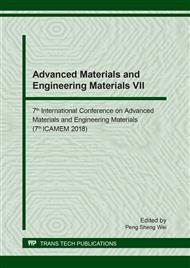[1]
W.A. Soffa, D.E. Laughlin, High-strength age hardening copper–titanium alloys: redivivus, Prog. Mater. Sci. 49(2004) 347-366.
DOI: 10.1016/s0079-6425(03)00029-x
Google Scholar
[2]
F. Wang, Y. Li, K. Wakoh, Y. Koizumi, A. Chiba, Cu–Ti–C alloy with high strength and high electrical conductivity prepared by two-step ball-milling processes, Mater. Des. 61(2014) 70-74.
DOI: 10.1016/j.matdes.2014.04.034
Google Scholar
[3]
S. Semboshi, T. Takasugi, Fabrication of high-strength and high-conductivity Cu–Ti alloy wire by aging in a hydrogen atmosphere, Journal of Alloys and Compounds, 580(2013) 397-S400.
DOI: 10.1016/j.jallcom.2013.03.216
Google Scholar
[4]
S. Nagarjuna, K.K. Sharma, I Sudhakar, et al., Age hardening studies in a Cu-4.5Ti-0.5Co alloy, Mater. Sci. Eng. A. 313(2001) 251-260.
DOI: 10.1016/s0921-5093(00)01834-7
Google Scholar
[5]
S. Nagarjuna, D.S. Sarma, Effect of cobalt additions on the age hardening of Cu-4.5Ti alloy, Journal of Materials Science, 37(2002) 1929-(1940).
Google Scholar
[6]
D.E. Laughlin, J.W. Cahn, Spinodal decomposition in age hardening copper–titanium alloys, Acta Metall. 23 (1975) 329-339.
DOI: 10.1016/0001-6160(75)90125-x
Google Scholar
[7]
A. Datta, W.A. Soffa, The structure and properties of age hardened Cu–Ti alloys, Acta Metall. 24 (1976) 987-1001.
DOI: 10.1016/0001-6160(76)90129-2
Google Scholar
[8]
S.F. Fang, Application of data mining methods to high-conductivity and high flexibility copper alloys and other metallic materials, PhD Thesis, Central South University, Changsha, (2009).
Google Scholar
[9]
J.A.K. Suykens, G.T. Van, B.J. De, J. Vandewalle, Least-Squares Support Vector Machines, World Scientific, Singapore, (2002).
DOI: 10.1142/5089
Google Scholar
[10]
D.F. Specht, A general regression neural network, IEEE Trans. on Neural Networks, 2 (1991) 568-576.
DOI: 10.1109/72.97934
Google Scholar
[11]
B. Walczak, D.L. Massart, The Radial Basis Functions-Partial Least Squares approach as a flexible non-linear regression technique, Anal. Chim. Acta. 331 (1996) 177-185.
DOI: 10.1016/0003-2670(96)00202-4
Google Scholar
[12]
D.M. Hummels, W. Ahemed, M. T. Musavi, Adaptive detection of small sinusoidal Signals in non-gaussian noise using an RBF neural network, IEEE Trans. on Neural Networks, 6 (1995) 991-995.
DOI: 10.1109/72.363435
Google Scholar


